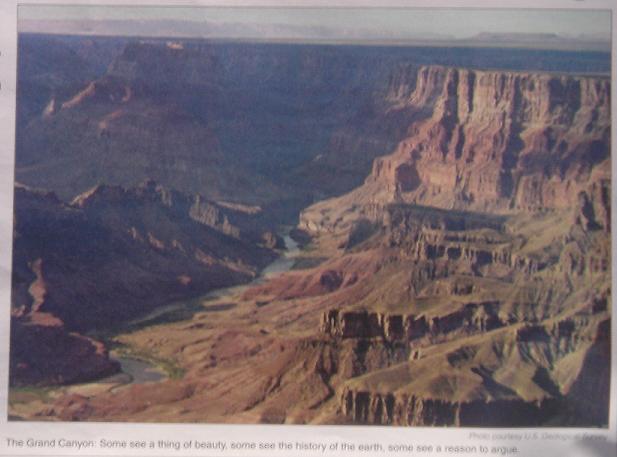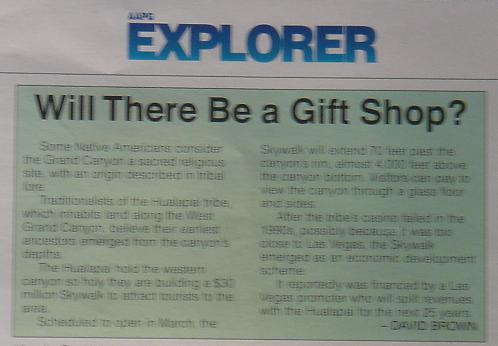How big is the chasm between geoscience and Creationism?
Right now, the size of the Grand Canyon.
Things got deep at the beginning of 2007 after the group Public Employees for Environmental Responsibility (PEER)
issued a breathy press release critical of the U.S. National Park Service.

PEER claimed:
- Grand Canyon National Park is not permitted to give an official estimate of the canyon's age.
- Park interpretive rangers cannot honestly answer questions about the geologic age of the canyon.
- The Park Service has failed to conduct a promised assessment of a Creationist-themed book sold at Grand Canyon outlets.
Those charges brought a huffy response from the government agency.
"The National Par Service uses the latest National Academy of Sciences explanation for the geologic formation
of the Grand Canyon," said a statement issued by David Barna, NPS chief of public affairs.
"We do not use the Creationist text in our teaching nor do we endorse its content. However, neither do we censor
alternative beliefs," the statement added.
They Said, They Said
Before long, holes started to appear on both sides of the story.
NPS defenders claimed the agency has never been coy about the age of the Grand Canyon or its geologic setting.
The Park Service's Web site describing the canyon contains this sentence:
"Geologic formations such as gneiss and schist found at the bottom of the canyon date back 1,800 million years."
And supporters said park rangers are not stifled when talking about the canyon's age and history. This is from Barna's statement:
"If asked the age of the Grand Canyon, our rangers use the following answer.
'The principal consensus among geologists is that the Colorado River basin has developed in the past 40 million years
and that the Grand Canyon itself is probably less than five to six million years old. The result of all this erosion is
one of the most complete geologic columns on the planet.
'The major geologic exposures in the Grand Canyon range in age from the 1.7 billion-year-old Vishnu Schist at the
bottom of the Inner Gorge to the 20 million-year-old Kaibab Limestone on the Rim.'"
Adding poignancy to the response was the fact that Barna himself has a degree in geology from Virginia Tech.
Barna said he worked as a geologist / physical scientists from 1975-90 for the Atomic Energy Commission, the
Nuclear Regulatory Commission, the U.S. Department of Energy and the U.S. Bureau of Mines.
When he signed the statement, Barna identified himself as a registered professional geologist with AIPG and a
licensed geologist in North Carolina.

The Book
At the center of the controversy is a book titled Grand Canyon: A Different View, by Tom Vail.
Vail, a Creationist author and speaker, founded Canyon Ministries and frequently leads rafting trips
through the Grand Canyon.
His book offers a Creationist view of the canyon and identifies its origin as a relatively recent, global Great Flood.
Shops at the canon park do have the book available for sale.
"This book is sold in the inspirational section o f the bookstore. In this section there are photographic texts,
poetry books and Native American books (that also give an alternative view of the canyon's origin)," said Barna's statement.
Critics quickly responded that only the park's largest bookstore has an "Inspirational" section, and that Vail's book has
appeared beside science texts in other park shops.
They also complained that a text offering a Creationist canyon origin as science is much different from books of
poetry or Native American myths.
Also, Vail's Web site (www.canyonministries.com) carries a blurb for
the Grand Canyon book with a notation, "A contribution to support Creation-based ministries is made for every book purchased."
Who Knows?
For geologists, the full geologic history of the Grand Canyon area remains far from certain.
"It's a heck of a conundrum, the history of the thing and how it got started," said John Warme, who has led
several Geotours of the canyon for AAPG.
Warme is a professor in the department of geology and geological engineering at the Colorado School of Mines.
He said the Grand Canyon Association published a book of proceedings from a symposium in 2000 on the geologic evolution
of the Colorado Plateau and the Colorado River during Cenozoic time, Colorado River: Origin and Evolution.
At least two books on the Grand Canyon followed the symposium.
Warme described Carving Grand Canyon: Evidence, Theories and Mystery, by Wayne Ranney, as a highly readable
book appropriate for the scientific layman.
He said a more scholarly look is presented in Grand Canyon: Solving Earth's Grandest Puzzle, by James Lawrence Powell.
Warme, who plans to take his 40th river trip down the canyon in August, also noted that some popular overview books about
the Grand Canyon can be less than accurate from a scientific viewpoint.
"I belong to the Grand Canyon Association. They have a general book on the canyon, and when I flip through the thing,
the guy who wrote it was not an expert," he said.
"There's some misinformation in there, but it is a useful book."
Does Paul Bunyan Know This?
Is the Park Service breaking its own rules by allowing the sale of a Creationist-themed book about the Grand Canyon?
PEER thinks so.
It quotes from a 2005 NPS director's order on interpretation:
"The interpretive and educational treatment used to explain the natural processes and history of the Earth must
be based on the best scientific evidence available, as found in scholarly sources that have stood the test of
scientific peer review and criticism . . .
"Interpretive and educational programs must refrain from appearing to endorse religious beliefs explaining natural processes."
But the NPS Web site has displayed an alternative explanation of the canyon's origin, quoting John Hance, an
early Grand Canyon guide and storyteller:
"It was hard work, took a long time, but I dug it myself.
"If you want to know what I done with the dirt, just look south through a clearin' in the trees at what they call
the San Francisco Peaks."
. . .